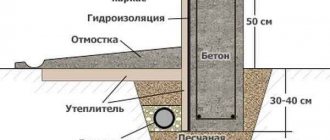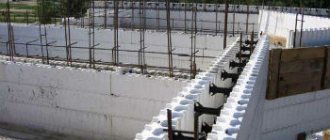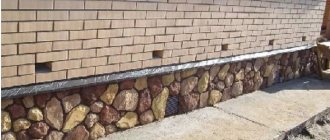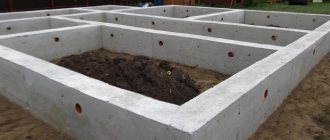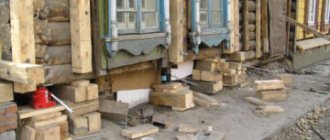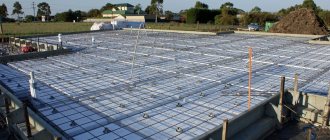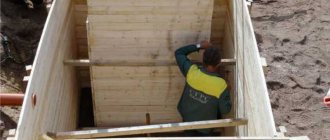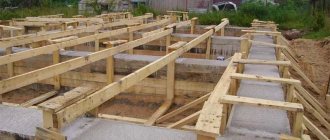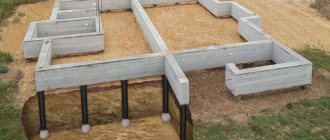Various types of frame structures are often used in construction. They are used to layout the volume of a house and to assemble the walls of buildings. Among such structures, formwork takes its place. It plays a role in laying the foundation, erecting walls and creating various parts of buildings.
Formwork is a frame assembly of elements. Regardless of the material underlying the foundation, formwork supports, shapes and strengthens it. The same applies to other elements of buildings for the construction of which it may be needed.
Types of permanent formwork
There are several options for arranging such a design. Consider those used in the construction of foundations.
Expanded polystyrene
Such structures can be mounted using two systems. The most popular and relatively inexpensive of them assumes that the insulation is located outside, that is, slabs, modules or hollow blocks are installed on both sides, between which concrete is poured. In this case, expanded polystyrene is secured using steel or plastic jumpers. Reinforcement is installed inside the slabs and the phased formation of the foundation wall begins. As soon as the concrete hardens (even before it reaches full strength), you can begin cladding.
As a rule, for such a laying scheme, blocks 1000-1500 mm long and 200-300 mm wide are used. This type of formwork is suitable for the construction of monolithic buildings up to 5 floors high.
There is also a system in which the insulation is located inside. In this case, a reinforcing mesh is laid on both sides of polystyrene foam up to 250 mm thick. After this, concrete is applied using shotcrete (spraying under high pressure). A similar method is used if it is necessary to reduce the construction time by another 20-30%. In addition, this scheme requires much less concrete mixture. For the foundation you will need almost 45% less.
Healthy! It is worth noting that polystyrene foam is not an environmentally friendly material; it can be dangerous in the event of a fire. In addition, this material does not withstand frost, so it is only suitable for regions with warm climates.
However, it is more convenient and quick to work with ready-made polystyrene foam blocks. They are sold in different shapes and are attached using a tongue-and-groove pattern. Essentially, you are building a Lego set. Since the blocks themselves are much larger and lighter than concrete ones, their installation is several times faster.
Made from extruded polystyrene foam
Many people confuse this type of construction with the usual “foam” one. But it is worth noting that extruded foam has increased strength. It burns much worse and does not react to frost at all, so it is suitable for installation in any region.
The design of this formwork is slightly different from the first option. In this case, adjustable type metal pins are used. Working with them is more difficult, but the finished structure is much stronger and accurately meets the requirements of the project.
Glass-magnesite
We are talking about LSU sheets, which began to be used for permanent formwork structures in the mid-20th century. This material is a mixture of oxide, sodium chloride, fiberglass, sawdust and polypropylene particles. This is a completely safe composition of natural origin for humans.
Glass-magnesite formworks are used for so-called weak foundations. The sheets themselves are light, so they are often used for walls so as not to load the finished building. This is a multifunctional, fireproof, moisture-resistant, elastic material that has high thermal insulation properties.
Arbolite
For this design, hollow wood-concrete blocks or panels are used. 90% of the total volume of such blocks is wood chips, so the material can rightfully be called the most inexpensive and environmentally friendly. The only drawback is the rather large thickness of the resulting walls.
Compared to concrete blocks, which today are practically not used for such formwork structures, wood concrete is lighter (does not require the use of construction equipment) and is easier to cut. This material is also resistant to fire (withstands up to 90 degrees of heat) and does not freeze.
Metal
This is the most expensive material for the manufacture of permanent formwork, therefore it is most often used in the construction of industrial facilities. Such structures are made of steel or aluminum sheets 1-2 mm thick, which are mounted on a metal frame
At the same time, it is important to correctly calculate how many clamps are needed so that the metal sheets do not bend after pouring the concrete mixture
Each type of formwork is more or less suitable for different projects.
Advantages
Advantages of permanent polystyrene foam formwork:
- The main advantage of fixed structures made of lightweight materials is the presence of an auxiliary function. In addition to forming a space for pouring concrete, polystyrene foam formwork simultaneously serves as insulation . Walls and foundations built using monolithic technology will not require additional insulation, which will save significant money. If you use traditional wooden formwork instead of expanded polystyrene, even without dismantling it after completion of the work, this effect will still not be achieved. With a reduced thickness of the monolithic floor, polystyrene foam boards allow you to retain up to 35% more heat than when constructing walls made of concrete or brick of standard thickness;
- In addition to retaining heat inside the building, the permanent foundation formwork made of polystyrene foam protects from moisture , which is especially important in the off-season and winter. As a result, the service life of a monolithic foundation, even in unfavorable conditions, increases by 20%;
- ease of assembly of formwork. Even an untrained builder can assemble permanent formwork from expanded polystyrene with his own hands;
- general reduction in construction costs. If we take into account that a significant part of the estimated cost is the cost of the foundation and walls, and the use of permanent formwork allows you to reduce the thickness of the wall due to additional thermal insulation and, accordingly, reduce the cost of the foundation, the overall benefit, compared with the traditional method, can reach 30%;
- the use of expanded polystyrene helps to achieve uniform strength gain in concrete at low temperatures (up to +5°C) . Thermal insulation keeps the temperature of the solution inside and at the edges of the pour at approximately the same level, so the hardening process occurs more evenly, which increases the strength characteristics of concrete. In wooden formwork, the solution quickly cools along the edges and the initial temperature inside is maintained, as a result of which the strength gain is uneven and the quality of the concrete decreases.
Characteristics of EPS formwork.
Cost of formwork and average market prices
| Appearance | Name | Dimensions, mm. | Thermal insulation thickness, mm. | Price (per sq.m.) |
| Series 25 (one-piece) | ||||
| Main wall block | Length – 1250 Width – 250 Height – 250 | internal – 50 external – 50 | From 490 rub. | |
| Wall end block | From 500 rub. | |||
| Corner wall block (left/right) | Length – 700/450 Width – 250 Height – 250 | From 500 rub. | ||
| Rotary wall block | Length – 700 Width – 250 Height – 250 | From 500 rub. | ||
| Series 30 (one-piece) | ||||
| Main wall block | Length – 1250 Width – 300 Height – 250 | internal – 50 external – 100 | From 560 rub. | |
| Wall end block | From 570 rub. | |||
| Corner wall block (left/right) | Length – 1250/500 Width – 300 | From 570 rub. |
Comparative cost per 1 m2
Let's consider it in more detail using the example of popular manufacturers. First, let's find out: what explains this cheapness? First of all, the production process does not involve any special costs, which is why the price may jump slightly only due to increased demand in a particular region of the country.
Thus, it produces a wide range of polystyrene foam blocks at the following prices:
- straight blocks - from 490 rubles;
- straight blocks 5 cm thick - about 800 rubles;
- 10-centimeter corner products - the same;
- jumpers and various kinds of plugs - about 25 rubles each.
Note! These are Moscow prices. If we take, for example, Blagoveshchensk, then such blocks there will generally cost about 300-350 rubles apiece
Permanent formwork made of polystyrene foam is often constructed from blocks produced by Samara. The cost of its products starts from 780 rubles; The products are distinguished not only by high quality, but also by the ideal compatibility of foam with plastic.
The most expensive blocks are products from Technoblock, lined with artificial stone. They cost about 1800-2500 rubles per square. Be that as it may, the costs will still be lower than if any other building material were used.
Technology for laying permanent polystyrene foam formwork
To correctly place permanent polystyrene foam blocks before pouring liquid concrete, you do not need any special skills. By following the requirements, the structure can be assembled without problems.
The walls of the house can be assembled from ordinary wall, as well as from rotary and corner polystyrene foam blocks
How to install an auxiliary structure
When starting to construct formwork from polystyrene foam blocks, you need to understand that the process is reminiscent of assembling a construction set. Each structural detail made of artificial raw materials has recesses at the bottom and spikes at the top. Therefore, the blocks are connected tightly and easily assembled into the desired structure.
Grooves and protrusions make it easy to assemble the formwork
Expanded polystyrene formwork is installed using the following steps:
- The foundation of the house is covered with canvas, which serves as a barrier to moisture. The first line of expanded polystyrene blocks is placed on the waterproofing material. Reinforcement elements are threaded inside them (vertically), ensuring reliable connection between all fragments of the structure. When placing blocks, they look to see if the dimensions correspond to the specified parameters, monitor the shape of the formwork and leave voids for outlets for internal partitions.
- The next lines of blocks are set so that they overlap the joints of the structural elements laid earlier.
- The structure is strengthened along the perimeter, that is, two metal rods are inserted into each line of blocks. The reinforcement is immersed in the material exclusively in the horizontal direction. To facilitate this task, small protrusions are created on the jumpers on the inside of the blocks. The metal elements are laid with overlaps and fastened to each other with steel wire. In addition, the reinforcement is connected in the same way to pins inserted vertically into the base.
- The necessary communications are carried out through the created structure. Then mounting holes are made in the formwork. It will not be possible to do this later: poured and already hardened concrete will become a serious obstacle.
- For pouring, use a composition that is devoid of large crushed stone, since it is capable of deforming the walls of the polystyrene foam structure. The formwork is filled with mortar in layers of one meter. The penultimate layer of concrete is pressed and leveled. When it has completely hardened, pour the last layer of mortar.
Video: how to connect walls made of permanent formwork with a roof
https://youtube.com/watch?v=QahclbGdKIQ
Is it possible to make a permanent structure from polystyrene foam yourself?
At the plant, expanded polystyrene blocks are produced using complex technology in several stages:
- Construction raw materials are treated with water vapor, which in production is called pre-foaming. As a result, the pores of the material become wider, and the material acquires a different density - 35 kg/m³.
- Foamed polystyrene foam is kept in a hopper until it is ready for further processing. After a day, the condition of the granules in the material is normalized and excess liquid comes out of them.
- Blocks are formed from expanded polystyrene. To do this, the material is placed in special molds and foamed again.
- The finished blocks are cooled with water and removed. After this, there is a break in production for about 24 hours. The exact downtime depends on the humidity and air temperature in the room where the formwork is being made.
- Waste from production is crushed and converted into a storage facility. The remaining material can be used again.
The polystyrene foam formwork block is the result of multi-stage processing of the material
It is very difficult to repeat all of the above steps at home. In addition, the production of polystyrene foam blocks involves the use of a steam generator - an expensive apparatus.
The steam accumulator for the manufacture of permanent formwork must have certain characteristics:
- foaming temperature - from 100 to 115 degrees;
- molding temperature - from 130 to 140 degrees;
- steam pressure during foaming of the material - from 1 to 1.5 atm;
- steam pressure during the molding process - 4–5 atm;
- steam consumption during foaming of raw materials - from 50 to 100 kg/h;
- steam consumption during molding - from 25 to 50 kg/h.
Expanded polystyrene blocks are produced at the factory; it is better not to undertake their production at home
In addition to the steam generator, the production of polystyrene foam blocks requires pneumatic transport, a residue crusher, a receiving hopper and components.
It turns out that making polystyrene foam blocks with your own hands is unwise. It’s easier and cheaper to purchase ready-made permanent formwork.
Arrangement of the foundation of a building without the use of formwork
In some cases, it makes sense to make a foundation without using any formwork. For example, during the construction of a small building, some excess consumption of concrete is compensated by the simplicity and speed of casting the concrete base. Of course, such a foundation is not suitable for a house with a basement. Moreover, without the use of formwork, the foundation can be built on soil that does not crumble, that is, with a certain clay content.
Pouring a strip foundation without the use of formwork
To arrange a strip foundation, a trench is dug under it in accordance with the contours of the building and a depth of up to 1 m. A sand cushion is laid at its bottom in a layer of 10-15 cm. The sand is moistened and thoroughly compacted. To improve the characteristics of concrete, it is recommended to cover the side walls of the trench with roofing felt or thick polyethylene. Next, a frame of reinforcement is built and concrete is poured.
This is interesting: Floor-to-ceiling windows on the balcony: let’s write down the main thing
Preparing the base for the grillage
As noted, the pile foundation grillage can be located in three positions relative to the ground level. The production of each of them requires its own approach to the process of preparing the work site. For any type of monolithic grillage, it is necessary to first level the future construction site, giving it the maximum possible flatness and horizontality.
Position of the grillage relative to the ground level
When performing work in areas with high humidity, in order to avoid waterlogging of the future strip foundation, which may be a grillage, high-quality drainage should be performed. To do this, ditches are dug along the perimeter of the construction site, directed towards the general slope of the area.
The last stage of preparatory work is marking the future foundation. It involves driving steel stakes made of reinforcement into the ground at the outer and inner corners of the future tape and connecting them with a strong cord. Pile foundation rods will be installed inside the markings, and concrete pouring of their heads will be carried out.
If it is necessary to manufacture a recessed monolithic grillage inside the completed marking, it is necessary to remove the soil to the required depth, usually 500-800 mm. You can perform this operation manually using an entrenching tool or use the services of specialized construction equipment.
After preparing the trench for the monolithic grillage, it is necessary to install piles. Currently, the following types are most widespread:
- Drivers;
- Screw;
- Bored monolithic.
Any of them can be used when installing a pile-grillage foundation.
Making permanent formwork with your own hands
Let's consider the process of creating permanent formwork from sheet materials with independent cutting using the example of EPS (extruded polystyrene foam).
Unfold the sheets into fragments corresponding to the width and length of the compacted trench. From the remnants, cut out strips for sides 20–25 cm high. The total length of the sides should correspond to the double perimeter of the trench + 20% for overlap at corner points.
Place the sheets in the trench so that the sides rest on the EPS layer and do not touch the ground. Secure the sheets at the corners by piercing the material with plastic ties of the SVT system.
Place the halves of plastic ties between the vertical sheets and secure them together. If the system does not click tightly enough, tighten the connections with pliers.
Install reinforcing bars above and below the horizontal ties. To ensure that the metal is embedded in the thickness of the concrete, place pieces of polystyrene foam under the rods. Special grooves on plastic ties will help maintain the same distance between the reinforcement bars throughout the entire foundation.
Tie the rods together with thin wire, folded 2-3 times. In the same way, the reinforcement can be tied to plastic ties.
Build up the foundation with whole sheets of EPS, having previously attached narrow strips of the same material to them using plastic clips. Place the prepared sheets as shown in the figure
When installing, pay attention to the location of the grooves and ridges on the sheet.
Attach the vertical sheets to each other with ties, install and tie the reinforcement using the technology described above. You should get at least two plastic reinforcement belts, approximately at a distance of 10 cm from the top and bottom edges of the sheet.
Attach locking plates to the sharp ends of the plastic ties and trim off the ends that remain free.
Fill the reinforced formwork with cement-sand mortar
To prepare concrete, you can use your own concrete mixer, but you will need a lot of solution. If you doubt that you can pour the entire foundation in a day, it is better to use the services of an industrial concrete mixer tank.
Remove air bubbles with a construction vibrator and level the concrete surface. In this case, it is impossible to expel the air with a reinforcing rod, since the metal will damage the formwork, easily piercing the EPS sheet.
After the foundation concrete has completely hardened, you can continue pouring the walls using the same technology, but such a foundation can also be used with other materials.
Video: technology for building a house with permanent formwork from particle blocks
https://youtube.com/watch?v=Aqg7_Xdw5aE
When giving preference to one of the permanent formwork options, consider not only your financial capabilities and labor costs, but also the purpose
For example, in areas with swampy soil you should not use blocks based on wood chips, and in cold regions you should pay attention to a material with a minimum thermal conductivity coefficient. In this case, you can quickly build a warm house without extra financial costs.
Flaws
These permanent structures for concreting have their disadvantages:
- a structure erected using permanent formwork cannot be rebuilt or reconstructed. When planning construction, especially individual construction, you need to take this feature into account and immediately approve the final design of the building. It is also important to accurately mark and immediately lay all communications at the time of pouring monolithic walls;
- It is very important to carefully adjust all blocks in such a way as to prevent breaks. Loose formwork will cause moisture to penetrate into the base and cause fungus to form. It is especially important to pay attention to this drawback for novice builders who assemble permanent foam formwork with their own hands;
- The main disadvantage is the impossibility of directly pouring the solution at temperatures below +5°C. There are also problems at high temperatures - in hot weather it will be necessary to additionally moisten the hardening solution;
- dense protection with polystyrene foam boards does not allow the walls to “breathe”. To correct this drawback, designers need to provide in advance for the installation of a forced-type ventilation system. Only this approach will help cope with the greenhouse effect indoors, while maintaining thermal insulation benefits.
Popular manufacturers and prices
Prices may vary depending on the region and seasonality, but for the most popular manufacturers the average cost will be:
A straight wall block 50 mm thick produced by Mosstroy will cost about 500 rubles, a more complex corner element - 780 rubles. Additional elements cost about 30 rubles on average.
The cost of standard blocks from Samara “Thermomonolit” will be 750-780 rubles. The higher price is justified - in addition to polystyrene, plastic is added to the formwork blocks, which gives the product increased strength.
The most expensive blocks include those made in Moscow - their price reaches 2,500 rubles. But such a difference with standard products from other manufacturers is justified. Each element is covered with cladding in the form of artificial stone. Additional external finishing is not required for such material.
Main characteristics of expanded polystyrene formwork
- The formwork class is the main quality parameter and is assigned 1; 2 or 3, depending on the availability of an exact fit in the manufacture of formwork parts. All deviations are regulated by standards. Example: for non-removable blocks of the 1st class, the deviation limit of the linear size is no more than 0.8 mm, for the 2nd class - no more than 1.5 mm. The 3rd accuracy class is not regulated, but is negotiated with the customer. The accuracy requirements are quite strict.
- Average density 25-30 kg/m3, increased density 47-50 kg/m3. Weight of one sq. a meter of wall 300 mm thick (150 mm concrete + 150 mm two layers of polystyrene foam) is up to 350 kg without finishing layers.
- Thermal conductivity coefficient Kt = 0.036 W/m*deg K. for polystyrene concrete Kt = 0.08 – 0.038 W/m*deg K
- Heat transfer resistance of at least 3.2 m2*degree K/W
- Frost resistance is excellent F300-F600, that is, up to 600 cycles of alternating freezing and thawing
- Volumetric water absorption 0.1% per day
- Vapor permeability coefficient 0.032 mg/m*h*Pa
- According to flammability, it is classified as group G1 - low-flammability. In terms of fire resistance, the fire resistance limit of a 250 mm thick wall is up to 2.5 hours. In terms of smoke generation, group D1 produces virtually no smoke
- Soundproofing. The best performance of all building materials. You can build near highways and railways. Noise absorption about 50 dB
The maximum possible number of floors in world practice is up to thirty; in our country, as a rule, the tallest houses with polystyrene foam formwork are sixteen-story buildings
Important points
Recommendations:
- The formwork must be durable. Violation of the requirement will lead to distortion of the wall geometry and the solution will leak out.
- Strictly maintain 0 vertical. If the permissible deviation is exceeded, the wall may collapse.
- The next tier must be poured quickly, otherwise delamination may occur.
- The mandatory use of reinforcement will make the structure more durable.
Technology is making it easier to build walls. Even inexperienced people can build on their own if they follow simple requirements.
A video showing how easy it is to use permanent formwork:


